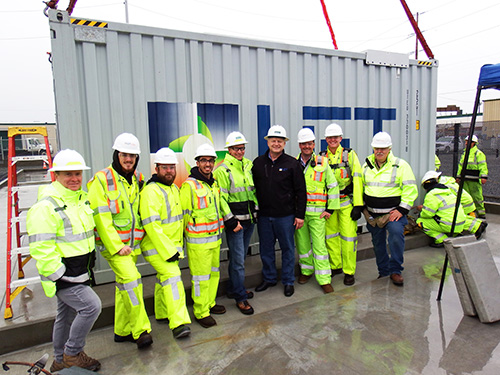 |
|
|
Workers install a 2MW/8MWh battery made in Washington State by UniEnergy Technologies at Snohomish County PUD, the largest capacity containerized flow battery in the world. |
CleanTech Day in Olympia gathered more than 100 CleanTech Alliance members and supporters in Olympia on Monday, January 30, to share the Clean Energy Fund’s economic impact for Washington State.
The Washington State Clean Energy Fund committed $76 million to expand clean energy research, development and deployment across our state. The $72.4 million allocated to date has attracted $128.7 million in outside funds to our economy while creating hundreds of jobs. That’s an average return of $1.78 for every $1.00 invested by the state.
Governor Jay Inslee proposed a $60 million Clean Energy Fund extension within his 2017 capital budget. Ask your legislator to support the Clean Energy Fund extension proposed within the 2017 capital budget to create more clean technology jobs and economic impact. Or, help spread the Clean Energy Fund impact story with this fact sheet.
Job Creation
Clean Energy Fund investments launched the Composite Recycling Technology Center (CRTC). The CRTC will create 200 highly skilled jobs in Port Angeles while diverting millions of pounds of carbon fiber waste from our landfills.
The Clean Energy Fund allowed several Washington State companies to demonstrate their products for the first time. The global market took notice. UniEnergy Technologies, 1Energy Systems (now Doosan GridTech), EnerG2 and Demand Energy attracted international customers and received significant investments in the past year. Each company has committed to staying in Washington State with plans to double staff in the coming year, creating hundreds of new jobs in Seattle, Mukilteo and Liberty Lake.
STEM Education and Research
The Clean Energy Fund created essential hands-on opportunities for STEM education and research across Washington State. These opportunities position our students to lead innovative companies of the future. University students and researches are working alongside Pacific Northwest National Laboratory to study transactive campus networks, demand and load response systems and much more.
Energy Resiliency
Energy storage and smart grid systems deliver energy resiliency to Washington State residents. The initial 2013 Clean Energy Fund deployed four utility-scale batteries statewide along with smart software and sensors for better grid management. More batteries and smart grid systems will be deployed as part of the 2015 Clean Energy Fund extension. The result will decrease power outages while providing community shelters during extreme weather conditions.
Bettering Lives
More than 2,300 commercial and residential energy projects are underway as part of the Clean Energy Fund revolving loan program. This pipeline is bettering the lives of Washington State residents by improving the health and comfort of their homes and workplaces while saving energy costs.